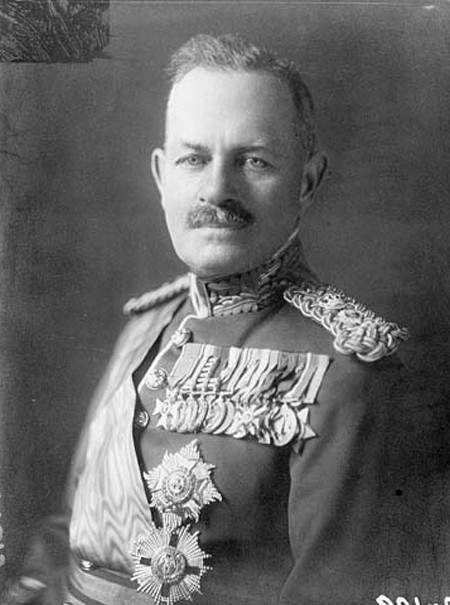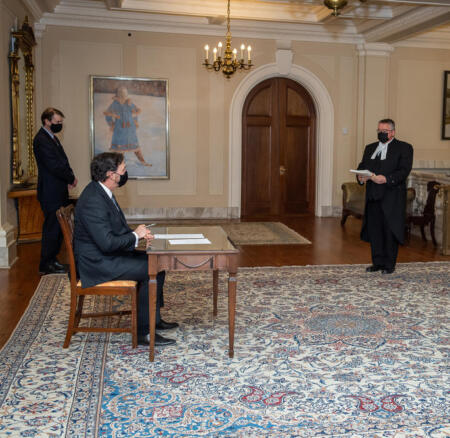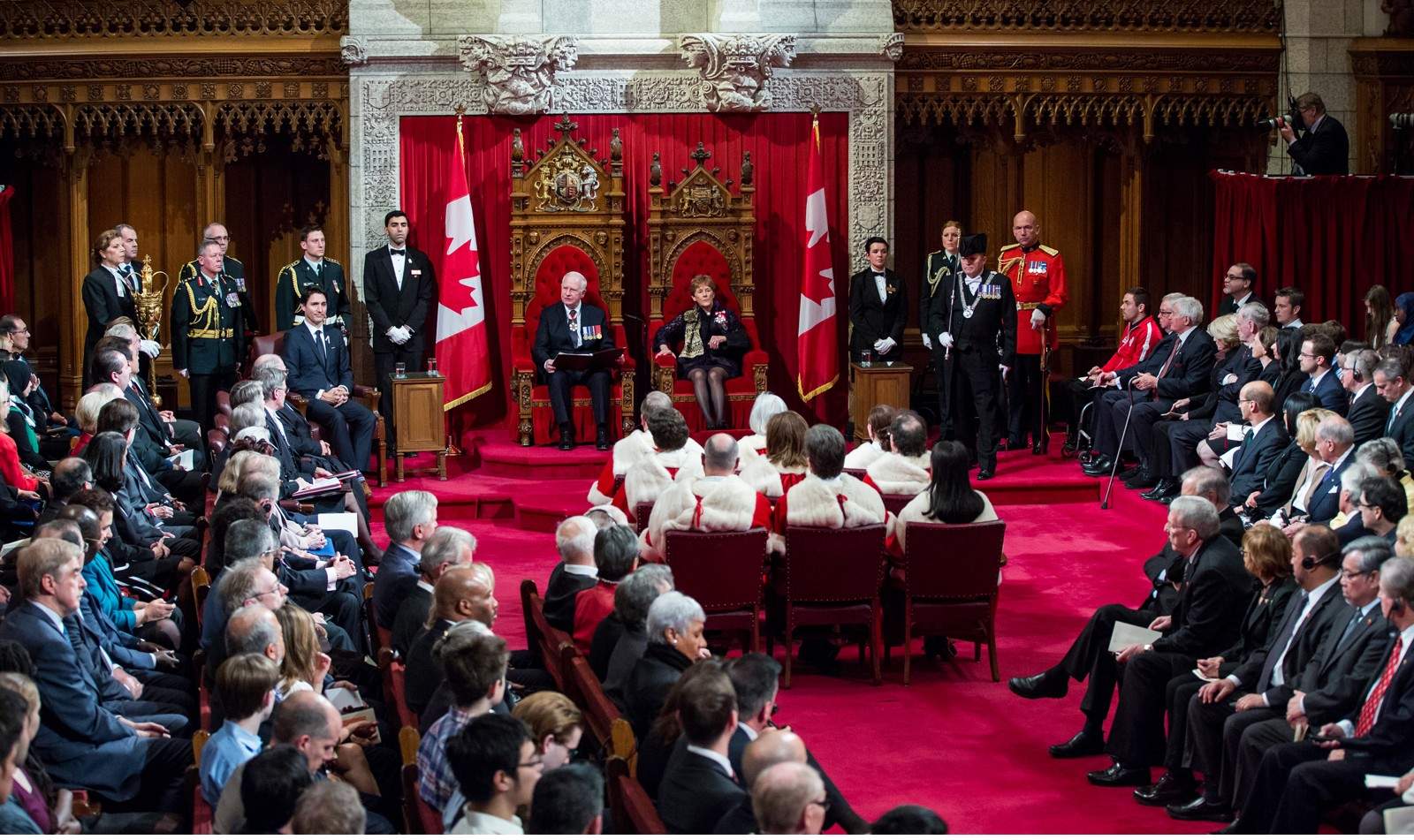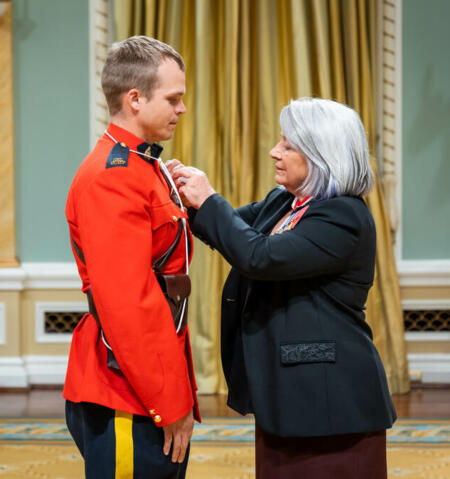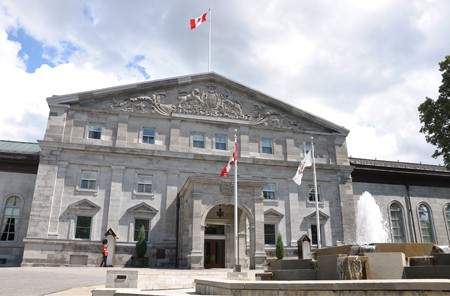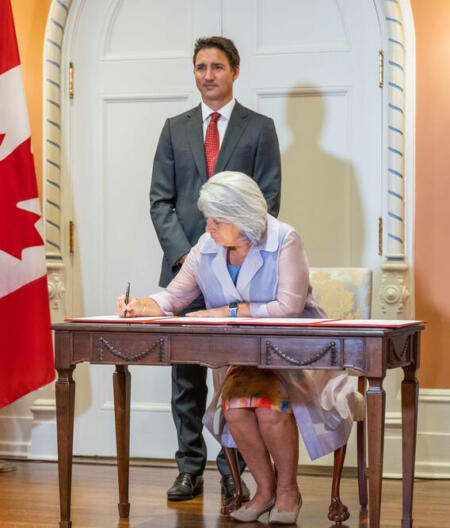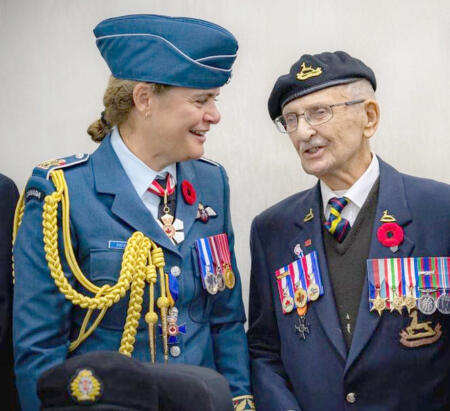The Governor General of Canada
As we learned in the monarchy chapter, Canada’s official “head of state” is the British monarch — someone who is rarely in Canada. Accordingly, the Canadian government appoints a full-time working stand-in for the king or queen known as the governor general.
History of the Governor General of Canada
The office of Governor General of Canada dates back to colonial times, when Britain would appoint men known as governor-generals to run the governments of its large and complicated colonies. (A “governor-general” is different than a governor in that he oversees many other lower-ranking governors.) The early governor generals of the British Canadian colonies were hands-on rulers, but as Canada’s government became more democratic, the governors slowly saw their powers decline, and were forced to share lawmaking authority with elected cabinets and parliaments. By the time the modern Constitution of Canada was written in 1867, it was understood that the governor general’s role was merely to supervise Canada’s elected parliament, and no longer make laws or decisions on his own.
For the remainder of the 19th century and into the early 20th century, governor generals were often advisers to the Canadian prime minister, and a spokesman for British interests in Canada. Yet as the decades went on, even this limited political role began to fade, and governor generals soon transitioned into mostly symbolic figureheads who did little more than bring a touch of British aristocratic glamour to Canada with fancy uniforms, impressive ceremonies, and classy parties.
By the time World War II (1939-1945) ended, Canada had won virtually complete political independence from Great Britain, and in recognition of this fact, Prime Minister Louis St. Laurent (1882-1973) ended the practice of Canada having British governor generals at all. In 1952, St. Louis picked Toronto-born Vincent Massey (1887-1967), a former Canadian ambassador, to be Canada’s first-ever Canadian governor general, and since then, all governor generals have been high-status Canadian citizens appointed by the prime minister of the day. There is no precise term, but they usually serve for about five years.
The Governor General’s Role Today
Today, it’s said that the governor general’s primary job is to “represent the monarchy in Canada” and generally perform the sorts of symbolic, figurehead duties associated with the monarch himself. This includes handing out medals, visiting hospitals, cutting ribbons, attending banquets and greeting world leaders at the airport. Just as the King is a symbol of Britain, the governor general is supposed to function as a symbol of Canada.
At the same time, the Canadian Constitution does grant sweeping powers to the governor general. A literal reading of the Constitution would seem to indicate Canada is ruled almost single-handedly by the governor general, in fact, since almost every major political decision is described as requiring his approval or assent. He is responsible for inaugurating the prime minister and his cabinet, signing bills into law, calling elections for the House of Commons, appointing judges and members of the Senate, commanding the Canadian military and a host of other important tasks. In practice, however, the governor general performs every single one of these constitutional duties in a purely symbolic fashion. He automatically approves every law, appointment and proposal the prime minister of Canada puts before him, making his signature, known as royal assent, something of a ceremonial “rubber stamp.”
What makes the governor general’s office interesting to a lot of people, however, are his emergency reserve powers. In theory, if there was a serious enough crisis to justify it, the governor general could choose to stop being a figurehead and actually use his constitutional powers in defiance of the prime minister. He could veto a law, deny an appointment, or, most controversially of all, fire the prime minister and appoint a new one. Even though no governor general has done something like this in 80 years, it’s still an interesting thing to speculate about. Just how bad would things have to get before the GG would be justified in intervening?
Governor General Johnston reads the 2015 Speech from the Throne in the Senate chamber.
Justin Trudeau/Flickr
Who Becomes Governor General?
The governor general is directly appointed by the prime minister of Canada, and until fairly recently it was common for the appointment to be openly partisan. Governor generals were usually retired politicians from the PM’s party, with the office used as a patronage present for years of faithful service. This became gradually more and more controversial, considering that the GG is supposed to be a figure of national unity and a neutral arbitrator in times of democratic crisis — two tasks which can be difficult for a partisan politician. In recognition of changing attitudes, Canada’s last five governor generals have all come from non-political backgrounds.
Since the GG is supposed to personify the “face of Canada” at ceremonies both at home and abroad, another recent trend has been for prime ministers to appoint governor generals who represent a particular minority group within the Canadian population. Of the last five governor generals, four have been women and three have been women of colour. The current governor general, Mary May Simon (b. 1947), is the first-ever Indigenous woman to the hold the job, and was specifically appointed by Prime Minister Justin Trudeau (b. 1971) to signify his seriousness about repairing relations with Canada’s Indigenous peoples. A creative governor general appointment is one important way a prime minister can signal his appreciation of the diversity of modern Canada.
Once in office, governor generals are often fairly quiet and low-profile. They avoid speaking out on controversial topics (one former GG quipped he learned to speak in nothing but “governor generalities”), and tend to busy themselves with inconspicuous public appearances such as visits to elementary schools, travels to rural communities, goodwill trips to friendly countries, and awards ceremonies for unsung Canadian heroes. It would not be an exaggeration to say that a great many Canadians would probably have a hard time naming the governor general if asked. The governor general’s most high-profile event is the semi-annual throne speech ceremony, in which the governor general reads the prime minister’s political agenda for the coming year before a joint session of parliament.
Former Governor Generals of Canada
The British governor generals who served Canada between 1867 and 1952 are not particularly well remembered today, and most modern governor general lists usually focus exclusively on the Canadian men and women who have held the office since 1952.
Here they are, in reverse chronological order.
Mary May Simon (2021- )
Prime Minister Trudeau's second governor general, Mary May Simon (b. 1947) was the first aboriginal person appointed to the post. The oldest governor general in a long while, she has spent nearly 50 years working for — and often leading — various national and international organizations relating to the Arctic and the Indigenous peoples who live there.
Richard Wagner (2021)
If the governor general resigns or dies in office, the Chief Justice of the Canadian Supreme Court takes over. Chief Justice Robert Wagner (b. 1957) accordingly served a acting governor general of Canada for seven months in 2021 following the resignation of Julie Payette. Officially, the title of an acting governor general is "administrator of the government."
Julie Payette (2017-2021)
In 2017 Julie Payette (b. 1963) became the first governor general appointed by Prime Minister Justin Trudeau (b. 1971). A former astronaut, Payette is one of the few Canadian women to visit outer space, and her appointment was intended to be inspiring. Unfortunately, however, Payette's term was deeply troubled — she was said to dislike the job and the press was filled with stories claiming she was mean and cruel to her staff. In 2021 she resigned amid growing criticism.
David Johnston (2010-2017)
Dr. David Johnston (b. 1941) was a career academic who worked many decades as a professor of law before serving as president of the University of Waterloo. While a respected figure of the Canadian establishment, he had a relatively low public profile as governor general.
Michaëlle Jean (2005-2010)
A Haitian refugee with an inspiring life story, the glamorous Michaëlle Jean (b. 1957) worked as a host of a documentary TV series before being appointed GG. Presiding over an era of closely-divided parliaments, she was pressured to intervene in politics during a few heated moments, but always declined. After her retirement, she served a short, controversial term as head of La Francophonie, a network of French-speaking nations.
Adrienne Clarkson (1999-2005)
Hong Kong-born Adrienne Clarkson (b. 1939) was the first non-white person to hold the GG’s position, and the first without an actively political background. Like her successor, she was a former TV host of mild fame. Clarkson faced criticism for living a bit too lavishly on the taxpayer's tab, a controversy that has followed her into retirement.
Romeo LeBlanc (1995-1999)
A longtime Liberal politician with almost three decades of service to the party, former cabinet minister Romeo LeBlanc (1927-2009) was the conventionally partisan appointment of Liberal prime minister Jean Chretien (b. 1934). LeBlanc was notable for being an Acadian — a member of New Brunswick’s French-speaking community.
Ray Hnatyshyn (1990-1995)
The son of poor Ukrainian immigrants, Ray Hnatyshyn (1934-2002) once quipped that his last name resembled “the top line of an eye chart.” He served as attorney general in the cabinet of Prime Minister Brian Mulroney (b. 1939) before Mulroney promoted him to the top job.
Jeanne Sauvé (1984-1990)
Madame Sauvé (1922-1993) was a high-profile female politician at a time when Canada didn't have many. After serving in the cabinet of Prime Minister Pierre Elliott Trudeau (1919-2000), in 1980 she became the first female speaker of the Canadian House of Commons, and then first female governor general shortly after.
Edward Schreyer (1979-1984)
Eager to tweak the establishment with an anti-elitist appointment, Prime Minister Trudeau settled on Ed Schreyer (b. 1935). The former NDP premier of Manitoba was a fairly drab, working-class guy, and far from a model aristocrat. He later attempted a political comeback with an unsuccessful run for parliament in 2008.
Jules Léger (1974-1979)
A longtime ambassador, Jules Légar (1913-1980) was a member of a powerful clique of diplomats that helped shape Canada’s postwar foreign policy. Tragically, he was badly crippled by a stroke shortly after becoming governor general. For the remainder of his term, his wife Gabrielle Léger (1938-1980) performed many of his duties.
Roland Michener (1967-1974)
With his white mustache, stocky build and jolly laugh, Roland Michener (1900-1991) fit the stereotypical image of an old-time governor general. A longtime Tory politician who served as Speaker of the House of Commons from 1957 to 1962, he was made governor general after his retirement from politics.
Robert Taschereau (1967)
Chief Justice Taschereau (1896-1970) served as acting governor general for a month in 1967 following the death of Georges Vanier.
Georges Vanier (1959-1967)
A decorated soldier from World War I (1914-1918), General Vanier (1888-1967) was an acclaimed war hero who had survived multiple serious injuries on the battlefield. After the war, he served in numerous diplomatic posts, including U.N. ambassador. Weak and infirm at the time of his appointment, he died in office. A devout Catholic, the Ottawa archdiocese proposed him for sainthood in 1990.
Vincent Massey (1952-1959)
The first Canadian to serve as governor general of Canada, Vincent Massey (1887-1967) was chosen, in part, because his refined, aristocratic manner was seen to help the transition from British lords. Born into a wealthy capitalist family, Massey served his country as ambassador to Britain and later the United States before becoming a history-making GG.
The Viscount Alexander (1946-1952)
Lord Harold Alexander of Tunis (1891-1961) was Canada’s last British governor general, and a fairly typical pick. A major-general during World War II (1939-1945), Lord Tunis was one of Britain’s top soldiers during the conflict, and served as a deputy to generals Montgomery (1887-1976) and Eisenhower (1890-1969). He was later appointed to the United Kingdom's House of Lords.
For a complete list of governor generals, please see the data chapter on heads of state.
More About the Governor General of Canada
